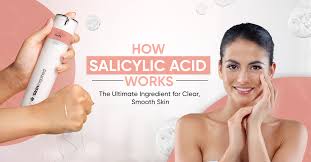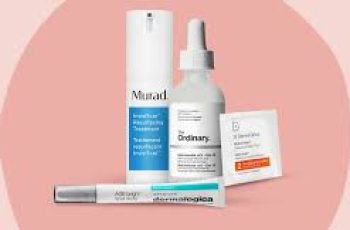
What is Salicylic Acid? A Complete Guide
If you’re looking to fight stubborn blemishes, you’ve probably heard of salicylic acid.
This powerful skincare ingredient is a type of beta hydroxy acid (BHA) and is known for its ability to clear spots, pimples, and zits effectively.
Whether you find it in over-the-counter creams or professional-grade treatments, salicylic acid works hard to help your skin stay clear and healthy.
If you want to learn more about all the benefits, we have a detailed blog post you can check out.
What Exactly is Salicylic Acid?
Salicylic acid might sound complicated, but it’s quite simple once you understand how it works. It belongs to a family of acids used in skincare called hydroxy acids.
These acids help exfoliate the skin — which means they help remove dead skin cells from the surface.
Hydroxy acids are split into two types: alpha hydroxy acids (AHAs) and beta hydroxy acids (BHAs). The difference lies in their chemical structure.
AHAs have a molecule that splits into one carbon atom, while BHAs split into two carbon atoms. Salicylic acid is a BHA.
Why does this matter? Because BHAs like salicylic acid are oil-soluble. This means they can penetrate deep into the oily parts of your skin, especially inside pores.
AHAs, like glycolic or lactic acid, are water-soluble and work mainly on the skin’s surface.
Salicylic acid’s ability to reach deep inside pores makes it excellent for removing excess oil, dirt, and bacteria. This unclogs pores and helps reduce blackheads, whiteheads, and pimples.
It also speeds up skin renewal and helps other skincare ingredients absorb faster.
If you want to understand more about the difference between AHAs and BHAs, check out The Beauty Insiders for a great explanation.
What Does Salicylic Acid Do for Your Skin?
Salicylic acid is best known as a powerful anti-blemish ingredient. Its main job is to exfoliate dead skin cells and clean out clogged pores. This helps fight current breakouts and stops new ones from forming.
But salicylic acid isn’t just for acne. Because of its skin-peeling properties, it’s also used in products to help with skin conditions like psoriasis and dandruff.
However, it’s important to speak to a doctor or dermatologist before using salicylic acid for these conditions to avoid irritation.
In higher concentrations, salicylic acid can treat tough skin problems like corns, calluses, and warts. These treatments are usually done by medical professionals only.
Trying these high doses at home can cause severe skin irritation, dryness, and discomfort.
Does Lemon Juice Contain Salicylic Acid?
Not exactly. Lemon juice doesn’t contain salicylic acid but has some similar benefits. It contains antioxidants that help protect the skin from damage caused by things like sun exposure and pollution.
Lemon juice also has citric acid and vitamin C, which exfoliate the outer skin layer and help fade dark spots or hyperpigmentation.
But using lemon juice directly on your skin is risky. It is highly acidic, which can dry out the skin and disrupt its natural pH balance. This imbalance can cause redness, itchiness, dryness, and worsen acne.
Because of this, it’s best to avoid using pure lemon juice on your face. Instead, opt for skincare products that are specially formulated to be gentle and effective.
How Can You Make a Salicylic Acid Peel at Home?
You can try a salicylic acid peel at home, but it’s important to be very careful and first talk to your doctor. If you get the green light, here’s a safe way to do it:
Start by cleansing your skin and gently patting it dry.
Use a salicylic acid product with no more than 15% concentration. Mix it with a carrier oil like sweet almond or olive oil in a bowl.
Using a fan brush, apply the mix evenly on your skin, avoiding the eye area.
Watch how your skin reacts and keep the peel on for no longer than 2 minutes.
Rinse off thoroughly with water.
Keep your skin slightly damp and apply a serum rich in hyaluronic acid to lock in moisture.
The next morning, use sunscreen with at least SPF 50 to protect your skin from UV damage.
Remember, salicylic acid is strong. Don’t rush into peels before your skin is used to the acid. Start slow, and always follow medical advice.
Can You Use Salicylic Acid Every Day?
Yes, you can use salicylic acid daily, but it depends on your skin type and what other active ingredients you use. If your routine already includes strong ingredients, be cautious.
Daily use is usually safe for oily or acne-prone skin but might be too harsh for sensitive or dry skin. Listen to your skin and adjust use accordingly.
We have a full blog post about how to use salicylic acid daily, so be sure to check that out if you want more detailed advice.
Why Is Salicylic Acid So Popular in Skincare?
Salicylic acid’s popularity comes from its ability to tackle multiple skin problems at once. It fights acne, exfoliates, reduces oiliness, and soothes inflammation.
It can help your skin look smoother, clearer, and healthier.
Many people find it effective because it unclogs pores and stops breakouts before they get worse. Its oil-soluble nature makes it unique among acids, helping those with oily or combination skin.
It also pairs well with other ingredients, speeding up results and improving overall skin texture.
Things to Remember When Using Salicylic Acid
Always start with a low concentration and slowly build tolerance.
Avoid using salicylic acid with other strong exfoliants or retinoids unless your dermatologist advises it.
Use sunscreen daily because salicylic acid can make your skin more sensitive to the sun.
If you experience excessive dryness, redness, or irritation, reduce use or stop and consult a doctor.
Avoid salicylic acid if you are allergic or sensitive to aspirin, as they are chemically related.
Final Thoughts
Salicylic acid is a fantastic tool in your skincare arsenal. Its deep-cleansing and exfoliating powers make it ideal for fighting blemishes and improving skin texture.
Whether you want to clear acne, reduce oil, or just maintain smooth skin, salicylic acid can help. Just remember to introduce it carefully and follow professional advice for best results.
If you have more skincare questions or want product recommendations, come find us on Instagram! We love helping people build healthier skin routines.


